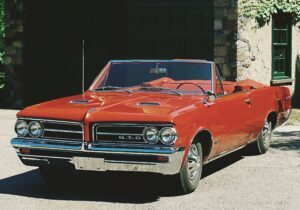
The muscle car king is dead. Long live the muscle car king.

The long, lingering final act of Pontiac final came to an end, over the weekend, when dealers sold off the last new cars bearing the once formidable Pontiac logo and General Motors let its franchise agreement with the brand’s final remaining dealers expire.
The brand once known by its catchy slogan, “We build excitement,” expired with a whimper rather than the squeal of tires.

Officially, Pontiac’s demise was set in stone last July, when GM emerged from Chapter 11 protection. The maker has originally hoped to save the brand as an outlet for specialty products, such as the Pontiac Solstice roadster. But in the end, GM buckled under White House pressure and agreed to abandon the division, along with Hummer, Saturn and Saab – half of its North American brands – in return for a $50 billion government bailout.
Two decades before, that would have seemed unthinkable – but then again, so would the idea of GM going bankrupt.
The Pontiac nameplate first appeared in 1900. Commemorating a Michigan Indian chief who led an unsuccessful uprising against British settlers, it was the product of the Pontiac Spring & Wagon Works which, eight years later, merged to become part of the Oakland Motor Car Company.

The name reappeared in 1926, at the New York Auto Show, this time as part of the ladder strategy envisioned by former GM Chairman Alfred P. Sloan, whose mantra was “a car for every purse and purpose.” Each brand occupied a different rung up the price ladder. And, in an era when marques like Chevrolet, Buick and Cadillac had far fewer model variants, GM created an assortment of secondary brands, such as LaSalle, a lower-cost version of Caddy.
Over time, those lower-status, lesser-known brands were abandoned. The exception was Pontiac which survived while the higher-priced Oakland division – which GM had bought in 1909 — was closed.
Pontiac had a series of hits-and-misses, over the years, but it hit its peak in the 1960s when the legendary John De Lorean and his colleagues put the emphasis on performance, coming up with products like the Chevelle SS and the GTO. Better known as the “Goat,” few cars could challenge it when the light turned green.
But, by the time the twin oil shocks struck, in the ‘70s, Pontiac had hit its peak, never to recover in an era where quality and fuel efficiency mattered more than horsepower to most motorists.

By mid-2009, when GM emerged from bankruptcy, Pontiac was selling barely a quarter its peak volume – it topped out in 1973 at 920,000 vehicles – and had dropped to 12th place among automotive brands.
Not that GM didn’t try. The maker struggled to find an alternative image to replace the muscle cars of the past. Hoping to come up with what former General Manager John Middlebrook once described as the “Swiss Army knife of automobiles,” the maker launched the Aztek, a much-derided offering that boasted plenty of flexibility but styling that has made the Pontiac crossover a staple of worst-ever lists.
When GM brought Bob Lutz on as its “car czar,” a decade ago, he struggled to find a way to tap into the brand’s heritage – but a remake of the GTO, using an Australian-made muscle car, flopped. So did a new version of the once popular Grand Prix sedan. Pontiac scored some good initial press with the Solstice roadster, which Lutz personally pushed through the sclerotic pre-bankruptcy GM system. But it was too little too late.
GM built the last G6 sedan on its own assembly line, appropriately enough, in suburban Pontiac, Michigan, on November 30, 2009. Shortly after, the last Pontiac Vibe ran down the line in Fremont, California, a factory GM had run as a joint venture with Toyota. That facility is now closed.
The old logo, a line drawing profile of Chief Pontiac can still be found on some old dealerships, including one near downtown Nashville. But most retailers, desperate to rebuild their businesses, are showing little interest in sentimentality. They’re tossing the signs and sales literature and moving on, many of them signing up with the foreign brands that helped drive Pontiac into the history books.







